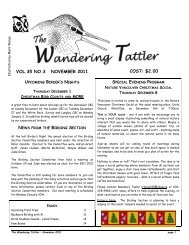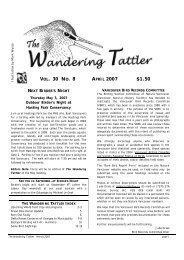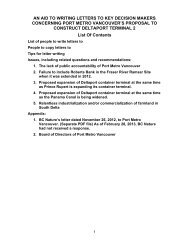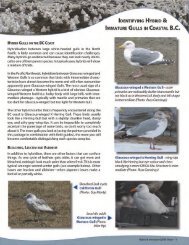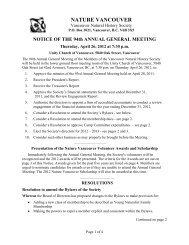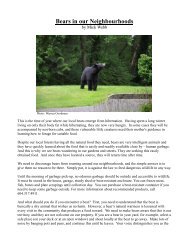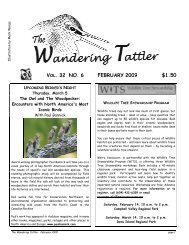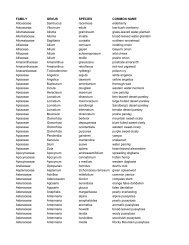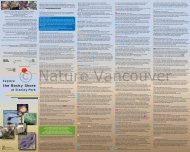Vancouver Naturalist_March 2012.pdf - Nature Vancouver
Vancouver Naturalist_March 2012.pdf - Nature Vancouver
Vancouver Naturalist_March 2012.pdf - Nature Vancouver
You also want an ePaper? Increase the reach of your titles
YUMPU automatically turns print PDFs into web optimized ePapers that Google loves.
Conservation Matters<br />
Conservation Section Members<br />
Visit YVR to Discuss Wildlife Control<br />
by J.M.Ryder<br />
In 2011, members of the <strong>Nature</strong> <strong>Vancouver</strong> Conservation Section<br />
were concerned to learn that unusually large numbers of ducks<br />
had been killed by intervention at <strong>Vancouver</strong> International Airport<br />
(YVR) during 2010. We are aware that the Wildlife Management<br />
team at YVR is charged with the difficult task of managing local<br />
wildlife in order to maintain the safety of aircraft and the travelling<br />
public. However, we did not understand why the number of ducks<br />
“culled” had risen from an average of 184 during 2005–2009 to<br />
1486 in 2010 (and then fell to 261 in 2011).<br />
After some brief discussions via e-mail, YVR staff offered to<br />
meet with <strong>Nature</strong> <strong>Vancouver</strong> members, an offer that we gratefully<br />
accepted. So on January 11, 2012, six members of the Conservation<br />
Section met with Simon Robinson of YVR’s Environment<br />
Department, Wildlife Management Consultant Gary Searing,<br />
Wildlife Control Supervisor Dave Ball, and Operations Manager<br />
Arnie Jassman. We spent a couple of hours around a table and then<br />
enjoyed a tour of the airfield to gain a clearer perspective on the<br />
nature of wildlife control activities.<br />
At the meeting, Simon outlined the basics of wildlife management<br />
at the airport and the circumstances that led to the unusually large<br />
cull of ducks, as follows:<br />
Three components to wildlife management:<br />
(1) Habitat Management – priority is to minimize features that<br />
attract birds (especially waterfowl and raptors), such as standing<br />
water on the airfield, and nearby fish-processing plants.<br />
(2) Active wildlife control – primarily harassment of birds<br />
so that they move away (and stay away) from the airport. Wildlife<br />
technicians have a variety of devices (described below) that they<br />
use to observe and scare the birds; one to three controllers are out<br />
on the airfield at all times. Sometimes it is necessary to kill birds,<br />
especially ducks, when they directly threaten aircraft safety.<br />
(3) Wildlife technicians monitor the wildlife (coyotes as well<br />
as birds) and report on the effectiveness of their actions. All strikes,<br />
culls (birds killed by intervention) and the estimated numbers of<br />
birds moved by harassment are recorded. A “strike” is recorded<br />
when there is physical evidence of a bird/aircraft collision (e.g.,<br />
bird remains, damage to the plane), and when a “strike” is reported<br />
by a pilot even if there is no physical evidence. (It may have been<br />
a near miss, but that is still a very dangerous event.)<br />
Increased Risk Late in 2009, it became apparent to the wildlife<br />
team that the number of birds on the airfield was increasing (and<br />
that this was not just a seasonal change). At the same time, control<br />
practices had changed, resulting in less active control of birds<br />
and more passive control, leaving more birds on the airfield. This<br />
resulted in more raptors and ducks, and with increased strikes and<br />
decreased culls the risk of a serious accident had become relatively<br />
very high. (In December alone, five duck-strikes were reported,<br />
with one of these involving six birds, while over the previous 10<br />
years, there were 3 to 10 duck strikes per year.)<br />
4 <strong>Vancouver</strong> <strong>Naturalist</strong> <strong>March</strong> 2012<br />
At the same time, it was discovered that unexpectedly large numbers<br />
of ducks were congregating on the airfield to roost at night, and<br />
rather than staying in a particular area, these birds were moving<br />
around unpredictably.<br />
Introduction of “Hunting Strategy” Recognition of increased<br />
risk required immediate action to address and reduce potential<br />
strikes. So a conscious decision was made by the wildlife control<br />
team to increase duck culls. This “hunting strategy” was based on<br />
the premise that waterfowl will avoid areas where hunting occurs.<br />
It was initiated in January 2010 and maintained throughout the<br />
year. The strategy was successful in that it reduced the number of<br />
ducks on the airfield, and since then, the lower numbers of birds<br />
have persisted even though the number of ducks killed in order to<br />
maintain an aversion to “hunters” has been significantly reduced.<br />
Ducks killed by intervention* (culls)<br />
2005 2006 2007 2008 2009 2010 2011<br />
311 319 218 39 34 1486 261<br />
* Culled birds were mostly Mallard, American Wigeon and<br />
Green-winged Teal.<br />
Raptor Trapping Program Raptors pose less danger than<br />
waterfowl: because they fly singly, the likelihood of multiple strikes<br />
is low. But they are still a significant hazard due to their large<br />
body size. Raptors (including owls) are much harder to control by<br />
harassment than ducks. They will move a short distance in response<br />
to a firecracker, but then return. To reduce the risk of raptor strikes,<br />
a raptor trapping program was initiated October 2010. The airport



